Here's something that gets you very close. You do not need polar coordinates to plot a decent ellipse. There is a so-called artist you can readily utilize.
You probably have to customize the axis labels and maybe insert an arrow or two if you want:
import numpy as np
import matplotlib.pyplot as plt
from matplotlib.patches import Ellipse
# initializing the figure:
fig = plt.figure()
# the (carthesian) axis:
ax = fig.add_subplot(111,aspect='equal')
ax.grid(True)
# parameters of the ellipse:
a = 5.0
e = 4.0
b = np.sqrt(a**2.0 - e**2.0)
# the center of the ellipse:
x = 6.0
y = 6.0
# the angle by which the ellipse is rotated:
angle = -45.0
#angle = 0.0
# plotting the ellipse, using an artist:
ax.add_artist(Ellipse(xy=[x,y], width=2.0*a, height=2.0*b, \
angle=angle, facecolor='none'))
ax.set_xlim(0,2.0*x)
ax.set_ylim(0,2.0*y)
# marking the focus (actually, both)
# and accounting for the rotation of the ellipse by angle
xf = [x - e*np.cos(angle * np.pi/180.0),
x + e*np.cos(angle * np.pi/180.0)]
yf = [y - e*np.sin(angle * np.pi/180.0),
y + e*np.sin(angle * np.pi/180.0)]
ax.plot(xf,yf,'xr')
# plotting lines from the focus to the ellipse:
# these should be your "rays"
t = np.arange(np.pi,3.0*np.pi,np.pi/5.0)
p = b**2.0 / a
E = e / a
r = [p/(1-E*np.cos(ti)) for ti in t]
# converting the radius based on the focus
# into x,y coordinates on the ellipse:
xr = [ri*np.cos(ti) for ri,ti in zip(r,t)]
yr = [ri*np.sin(ti) for ri,ti in zip(r,t)]
# accounting for the rotation by anlge:
xrp = [xi*np.cos(angle * np.pi/180.0) - \
yi*np.sin(angle * np.pi/180.0) for xi,yi in zip(xr,yr)]
yrp = [xi*np.sin(angle * np.pi/180.0) + \
yi*np.cos(angle * np.pi/180.0) for xi,yi in zip(xr,yr)]
for q in range(0,len(t)):
ax.plot([xf[0], xf[0]+xrp[q]],[yf[0], yf[0]+yrp[q]],'--b')
# put labels outside the "rays"
offset = 0.75
rLabel = [ri+offset for ri in r]
xrl = [ri*np.cos(ti) for ri,ti in zip(rLabel,t)]
yrl = [ri*np.sin(ti) for ri,ti in zip(rLabel,t)]
xrpl = [xi*np.cos(angle * np.pi/180.0) - \
yi*np.sin(angle * np.pi/180.0) for xi,yi in zip(xrl,yrl)]
yrpl = [xi*np.sin(angle * np.pi/180.0) + \
yi*np.cos(angle * np.pi/180.0) for xi,yi in zip(xrl,yrl)]
# for fancy label rotation reduce the range of the angle t:
tlabel = [(ti -np.pi)*180.0/np.pi for ti in t]
for q in range(0,len(tlabel)):
if tlabel[q] >= 180.0:
tlabel[q] -= 180.0
# convert the angle t from radians into degrees:
tl = [(ti-np.pi)*180.0/np.pi for ti in t]
for q in range(0,len(t)):
rotate_label = angle + tlabel[q]
label_text = '%.1f' % tl[q]
ax.text(xf[0]+xrpl[q],yf[0]+yrpl[q],label_text,\
va='center', ha='center',rotation=rotate_label)
plt.show()
The example above will result in this figure:

Explanations:
- You can use an
artist to plot the ellipse, instead of using polar coordinates
- The nomenclature is based on the definitions available on Wikipedia
- The
angle in the artist setup rotates the ellipse. This angle is later used to rotate coordinates for the rays and labels (this is just math)
- The rays are derived from the polar form of the ellipse relative to a focus.
- The angle
t runs from pi to 3.0*pi because I assumed that this would correspond to your idea of where the rays should start. You get the same rays for 0 to 2.0*pi. I used np.arange instead of linspace because I wanted a defined increment (pi/5.0, or 36 degrees) in this example.
- The labels at the end of the rays are placed as
text, the variable offset controls the distance between the ellipse and the labels. Adjust this as needed.
- For the alignment of the label text orientation with the rays, I reduced the angle,
t, to the range 0 to 180 degrees. This makes for better readability compared to the full range of 0 to 360 degrees.
- For the label text I just used the angle,
t, for simplicity. Replace this with whatever information better suits your purpose.
- The angle,
t, was converted from radians to degrees before the loop that places the label. Inside the loop, each element of tl is converted to a string. This allows for more formatting control (e.g. %.3f if you needed 3 decimals)


